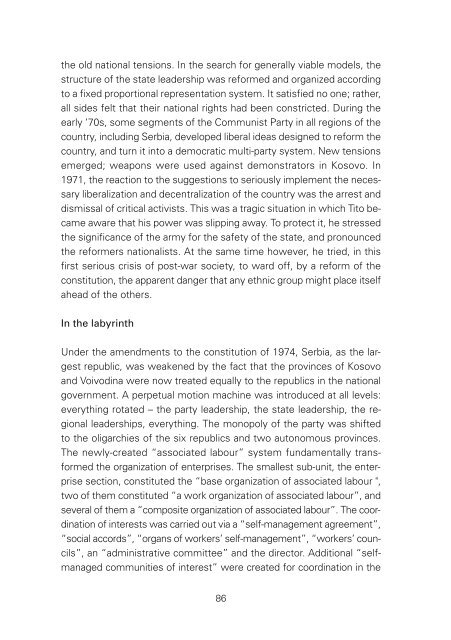The Contribution of Women to Peace and Reconciliation
The Contribution of Women to Peace and Reconciliation
The Contribution of Women to Peace and Reconciliation
You also want an ePaper? Increase the reach of your titles
YUMPU automatically turns print PDFs into web optimized ePapers that Google loves.
the old national tensions. In the search for generally viable models, the<br />
structure <strong>of</strong> the state leadership was reformed <strong>and</strong> organized according<br />
<strong>to</strong> a fixed proportional representation system. It satisfied no one; rather,<br />
all sides felt that their national rights had been constricted. During the<br />
early ‘70s, some segments <strong>of</strong> the Communist Party in all regions <strong>of</strong> the<br />
country, including Serbia, developed liberal ideas designed <strong>to</strong> reform the<br />
country, <strong>and</strong> turn it in<strong>to</strong> a democratic multi-party system. New tensions<br />
emerged; weapons were used against demonstra<strong>to</strong>rs in Kosovo. In<br />
1971, the reaction <strong>to</strong> the suggestions <strong>to</strong> seriously implement the necessary<br />
liberalization <strong>and</strong> decentralization <strong>of</strong> the country was the arrest <strong>and</strong><br />
dismissal <strong>of</strong> critical activists. This was a tragic situation in which Ti<strong>to</strong> became<br />
aware that his power was slipping away. To protect it, he stressed<br />
the significance <strong>of</strong> the army for the safety <strong>of</strong> the state, <strong>and</strong> pronounced<br />
the reformers nationalists. At the same time however, he tried, in this<br />
first serious crisis <strong>of</strong> post-war society, <strong>to</strong> ward <strong>of</strong>f, by a reform <strong>of</strong> the<br />
constitution, the apparent danger that any ethnic group might place itself<br />
ahead <strong>of</strong> the others.<br />
In the labyrinth<br />
Under the amendments <strong>to</strong> the constitution <strong>of</strong> 1974, Serbia, as the largest<br />
republic, was weakened by the fact that the provinces <strong>of</strong> Kosovo<br />
<strong>and</strong> Voivodina were now treated equally <strong>to</strong> the republics in the national<br />
government. A perpetual motion machine was introduced at all levels:<br />
everything rotated – the party leadership, the state leadership, the regional<br />
leaderships, everything. <strong>The</strong> monopoly <strong>of</strong> the party was shifted<br />
<strong>to</strong> the oligarchies <strong>of</strong> the six republics <strong>and</strong> two au<strong>to</strong>nomous provinces.<br />
<strong>The</strong> newly-created “associated labour” system fundamentally trans -<br />
formed the organization <strong>of</strong> enterprises. <strong>The</strong> smallest sub-unit, the enterprise<br />
section, constituted the “base organization <strong>of</strong> associated labour ",<br />
two <strong>of</strong> them constituted “a work organization <strong>of</strong> associated labour”, <strong>and</strong><br />
several <strong>of</strong> them a “composite organization <strong>of</strong> associated labour”. <strong>The</strong> coordination<br />
<strong>of</strong> interests was carried out via a “self-management agreement”,<br />
“social accords”, “organs <strong>of</strong> workers’ self-management”, “workers’ councils”,<br />
an “administrative committee” <strong>and</strong> the direc<strong>to</strong>r. Additional “selfmanaged<br />
communities <strong>of</strong> interest” were created for coordination in the<br />
86








